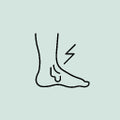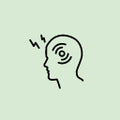Craniosacral therapy is a form of non-invasive manual therapy that has profoundly relaxing and therapeutic effects. It is based on the idea that there is a fluid rhythm in the body, a subtle, almost imperceptible movement that can be detected and modified by a trained therapist to restore your body to its natural balance. Involving gentle touches, it is a holistic process that integrates the physical, mental and emotional, providing a full range of benefits.
Understanding the Concept of Craniosacral Therapy
Craniosacral therapy, also known as cranial osteopathy, is a form of alternative medicine that relies on a gentle, non-invasive approach. Practitioners of this discipline believe in the existence of an imperceptible rhythmic movement of the bones of the skull. By gently manipulating these movements, they seek to restore the fluidity of energy circulating in the body, thus promoting healing.
The idea for this therapy came about through research conducted by Dr. Upledger. Faced with the inability to find an explanation in medical texts or from his colleagues on certain questions concerning the craniosacral system, Dr. Upledger began to conduct his own research. This investigation led to the development of Craniosacral Therapy.
It is important to note that this therapy is in no way a substitute for a medical consultation or a diagnosis made by a health professional. Indeed, despite the promises of craniosacral therapy, it has also been criticized and described as an unfounded theory by some.
The essential benefits of craniosacral therapy
Craniosacral therapy, despite some scientific controversy, has gained popularity due to its potential beneficial effects on health and well-being.
Craniosacral therapy practitioners believe that all illnesses are caused by energy or fluid blockages that can be released through physical manipulation. While we remind you that this treatment is not a substitute for a medical consultation, it can serve as a complement to a conventional care pathway.
Some research suggests that this therapy may benefit certain populations, including children with autism and/or sensory processing disorders. It is important to note, however, that the effectiveness of craniosacral therapy depends on the individual and the practitioner administering the treatment.
It is also important to mention that while some studies, such as those conducted by Upledger and Ernest W. Retzlaff at Michigan State University (1975-1983), have concluded that there is no evidence for the effectiveness of craniosacral therapy, the practice continues to be used worldwide. This discrepancy between scientific findings and the popularity of the therapy underscores the importance for patients to make informed choices.
The Process of Craniosacral Therapy Explained
The craniosacral therapist begins with a thorough assessment of your health. This step includes an open discussion about your symptoms, medical history, and any other factors relevant to your well-being. This is an essential part of therapy because it allows the practitioner to understand your current condition and plan a course of care that is tailored to your specific needs.
After this assessment, you will be asked to lie down on a therapy table, fully clothed. Then, the therapist will gently place his hands on your body, mainly on your skull and sacrum (the base of your spine). He will assess the craniosacral rhythm, a subtle movement that only a trained practitioner can perceive. Through this gentle, light touch, he will identify areas of blockage or restriction that could alter the circulation of cerebrospinal fluid.
Once the areas of tension have been identified, the practitioner will use different techniques to release these blockages and restore the balance of the cerebrospinal fluid. By releasing these barriers, the body is allowed to resume its self-healing process, relieving various health problems.
The forms of touch vary depending on the person's condition and the type of blockage identified. They can range from simple pressure to more complex mobilization involving gentle, slow movements.
At the end of the session, you will have some time to relax and fully integrate the effects of the therapy. The practitioner will be there to discuss your feelings with you and to answer any questions you may have.







